
* In the early 1960s, with the expanding war in Southeast Asia, the US Army began to arm helicopters as "gunships", the Bell UH-1 "Huey" utility helicopter becoming the iconic armed helicopter of the conflict. From early on, there was a belief that simply arming utility helicopters wasn't enough for the gunship role; a helicopter designed from the ground up as a gunship would be more survivable and effective.
The end result would be the well-known Bell AH-1 Cobra gunship -- but it was supposed a stopgap, the Army being focused on the bigger and more potent Lockheed "AH-56A Cheyenne" gunship. However, the Cheyenne never entered production, being canceled late in the development program; the Army then acquired the Hughes AH-64 Apache gunship in its place. Roughly in parallel, Sikorsky developed a gunship, the "S-67 Blackhawk", on company funds, but nobody wanted to buy it.
From the 1980s, the Army once again attempted to develop an advanced-technology gunship, the Boeing-Sikorsky "RAH-66 Comanche" -- but the development program ran out of steam with the fall of the Soviet Union, and the Comanche was canceled in turn. This document provides a history and description of the Cheyenne, Blackhawk, and Comanche. A list of illustration credits is included at the end.
* In the early 1960s, US Army considerations for a dedicated helicopter gunship led to the "Fire-support Aerial System (FAS)" program, which led in turn to the "Advanced Aerial Fire Support System (AAFSS)", a request for proposals (RFP) for AAFSS being issued in the summer of 1964. The AAFSS requirement specified a large, heavily-armed, high-speed compound helicopter -- that is, a rotorcraft with small wings and a forward propulsion system, combining features of a rotorcraft and a fixed-wing aircraft. The AAFSS was to have long range, permitting extended endurance in the combat area and self-deployment to foreign theaters, as well as combat avionics systems to permit fighting at night or in bad weather. It was also to be easy to maintain, and quick to turn-around for combat sorties.
The AAFSS was envisioned as serving in the helicopter support role -- providing backup for heli-borne troops in the combat zone. Bell, Sikorsky, and Lockheed submitted proposals in response, with the Army selecting the Sikorsky and Lockheed proposals for further development in early 1965. In the meantime, the Army pursued development of an interim helicopter gunship, to be developed on a fast-track basis to a less demanding specification, to serve as a stop-gap until the more sophisticated AAFS could be fielded. The result of that backup effort would be the Bell AH-1 Cobra gunship.
Following examination of a range of detailed proposals from Sikorsky and Lockheed for the AAFSS, on 3 November 1965 Lockheed won the contract with its "CL-840" proposal, the Army rejecting Sikorsky's "S-66". While Sikorsky was much more experienced in rotorcraft design than Lockheed -- Lockheed had never built a production helicopter -- the CL-840 was judged less expensive and risky. By the end of the 1965, the Army had released a final specification -- which added a number of requirements, most notably a guided anti-armor missile carriage capability, the AAFSS now also being seen as a "tank-buster". The anti-armor missile would emerge as the "BGM-71 TOW" anti-tank missile -- the name standing for "Tube-launched, Optically tracked, Wire-guided", with the missile trailing out wires to receive course corrections from its optical sighting unit.
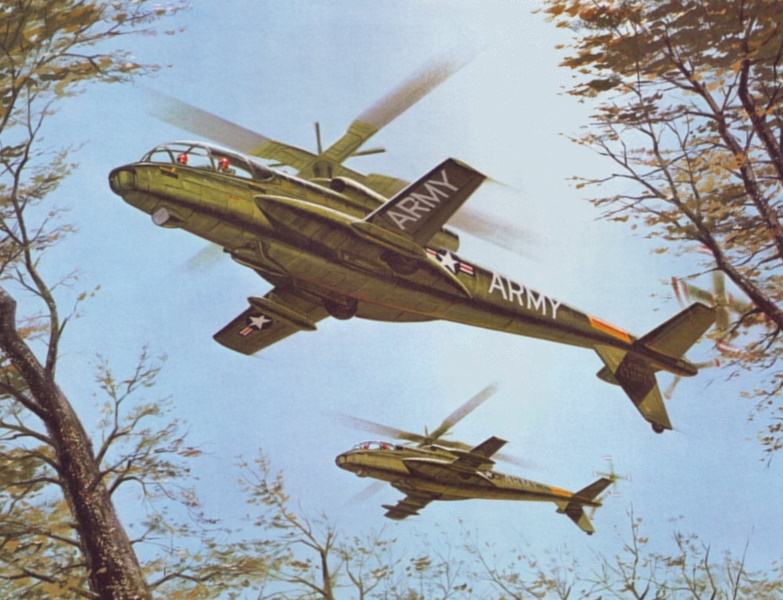
A contract for ten "AH-56A" prototypes was awarded to Lockheed in the spring of 1966, including one unequipped initial prototype, one ground-test prototype, and eight pre-production prototypes. Initial operating capability was scheduled for 1972 -- or earlier, if all went well. The expected buy was to be upwards of a thousand machines. A full-scale mockup was evaluated in 1966, with Lockheed then rolling out the first of the ten prototypes from the company's Van Nuys CA facility on 16 April 1967. The Army gave the machine the name "Cheyenne", in accordance with the service tradition of naming helicopters after American native tribes.
Initial flight was on 21 September 1967, with Lockheed test pilot Donald R. Segner at the controls, and Army Lieutenant Colonel Emil E. "Jack" Kluever -- the military project manager -- in the front seat as an observer. Segner then put on a public display on 12 December. All ten prototypes would be completed, the last being delivered in 1969.
* The AH-56A has often been compared to a dragonfly, being a slender, angular machine with a bug-eyed tandem canopy. There were low-mounted stub wings, connected to the fuselage via sponsons. At high speeds, the wings unloaded the rotor, which then only provided 20% of the total lift. The sponsons accommodated the retractable main landing gear, each assembly with single wheels, the gear retracting back into the fairings. The sponsons also contained fuel tanks, with the left sponson stowing an auxiliary power unit (APU) turbine for ground power as well. The sponsons also provided walkways for the aircrew and ground crew.
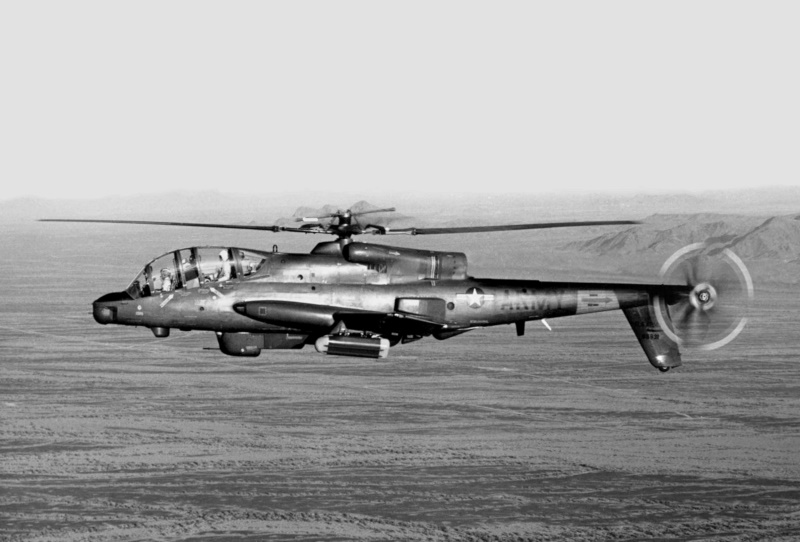
The main rotor, which had a rigid hub scheme, also had four blades -- of metal composite construction, using titanium, stainless steel, and aluminum alloy honeycomb. The rigid rotor provided a high degree of maneuverability. Lockheed had trialed the rigid-rotor system on a simple demonstrator, the "CL-475", from 1959, which led to the larger four-seat "XH-51A" to fully demonstrate the concept. Lockheed had demonstrated the rotor system for the AH-56A on a ground test tower.
The tail featured a full-span tailplane, plus a long ventral tailfin -- no dorsal tailfin -- the tailfin having a semi-retractable tailwheel on the end. There was a three-bladed, variable-pitch pusher prop behind the tail, plus a four-blade tail rotor on the left tip of the tailplane.
The AH-56A was powered by a single General Electric (GE) T64 turboshaft, developed for the Sikorsky S-65 / Sea Stallion heavy helicopter, driving the rotor system and the pusher prop. The initial engine variant was the T64-GE-16 turboshaft, downrated to 2,565 kW (3,435 SHP); it was later brought up to 2,930 kW (3,925 SHP), the drive system having been reinforced to handle the greater power. The ninth prototype had the T64-GE-76, with 3,010 kW (4,300 SHP). With its twin T64 engines, the Cheyenne was expected to be able to handily carry a full combat load under "hot & high" conditions. During the course of development, on the basis of feedback from Vietnam, Lockheed introduced a dust / sand filter for the engines; under dusty conditions, the main intakes would be shut, with air flowing in from filters below the engine housing.
Although the initial prototype had no gun armament, eventually the nose of the Cheyenne would feature a turret for a GE 7.62-millimeter Minigun six-barreled Gatling-type machine gun, or a 40-millimeter automatic grenade launcher; the decision was eventually made just to use the 40-millimeter grenade launcher. Late prototypes also had a turret for a 30-millimeter automatic cannon under the fuselage at the rear of the cockpit. The nose turret could pivot 100 degrees from the front centerline, while the 30-millimeter cannon could pivot a full 360 degrees. Mechanical stops prevented the armament from firing into the airframe.
The Hughes "BGM-71 "Tube-launched, Optically tracked, Wire-guided (TOW)" missile was in development as the AH-56A's tank-killer. It trailed wires for control; that was nothing new, but earlier wire-guided weapons required that the gunner manually direct the missile's flight, tracking it from a flare on the missile's tail. TOW had a new optical sight; all the gunner had to do was keep the target in the crosshairs, and the sight would automatically send course corrections to the missile. There was a turret for a periscopic sighting system between the two gun turrets; the sighting system had magnifications of 1.5x, 5.25x, and 12x, with the turret also accommodating a laser rangefinder and a TOW controller system.
There were two stores attachments under each stub wing, plus one under each sponson, for a total of six. The attachments under the sponsons were for external tanks only; the wing attachments were "wet", and also capable of hauling external tanks if necessary. The inboard wing attachments could each carry TOW wire-guided anti-armor missiles, the TOW then being in development; originally the packs had three rounds, as opposed to the two- or four-round packs that would become the norm. All the wing attachments could carry 7- or 19-round 70-millimeter (2.75-inch) unguided rocket pods.
___________________________________________________________________
LOCKHEED AH-56A CHEYENNE:
___________________________________________________________________
main rotor diameter:
15.62 meters (51 feet 3 inches)
tail rotor diameter (same as diameter of pusher prop):
3.1 meters (10 feet)
footprint length:
18.3 meters (60 feet)
fuselage length:
16.66 meters (54 feet 8 inches)
height:
4.18 meters (13 feet 8 inches)
empty weight:
5,540 kilograms (12,215 pounds)
loaded weight:
8,300 kilograms (18,300 pounds)
MTO weight:
11,740 kilograms (25,880 pounds)
maximum speed:
395 KPH (245 MPH / 210 KT)
cruise speed:
360 KPH (225 MPH / 195 KT)
service ceiling:
6,100 meters (20,000 feet)
range:
1,015 kilometers (630 miles / 550 NMI)
___________________________________________________________________
The gunner sat in the front, with the seat, firing controls, and periscopic sighting system pivoting along with the turret being controlled. The pilot had a helmet-mounted sight for weapons as well. In principle, the gunner could operate one turret, while the pilot operated the other -- though in practice, that would likely have been clumsy and generally impractical. Combat avionics were to be advanced for the time, with the Cheyenne to be one of the first helicopters with a cockpit CRT video display. That proved to be a real challenge, since at the time, nobody knew exactly how to make good use of the display; it hadn't been done before.
* Trials of the AH-56A began in September 1967, with the Cheyenne giving a public demonstration in December of that year. Some difficulties, notably a rotor instability that cropped up in low-altitude flight, were encountered, but progress in resolving the difficulties seemed satisfactory. However, on 12 March 1969, the third prototype crashed, going wildly out of control, with the rotor blades slicing the canopy and chopping off the tailboom, the machine falling to earth; the pilot, David A. Beil, was killed. The crash was determined to be due to pilot error, Beil having tried to fight an oscillation instead of simply releasing the controls, with the end result that the Cheyenne fell to earth. It also appeared that safety controls were disabled for that test flight.
Nonetheless, from that time on, the Cheyenne program went into decline. In April 1969, the Army publicly issued a scathing "cure notice" to Lockheed that cited a list of problems to be corrected, most significantly excessive vibration and excessive weight growth. In May, the Army canceled the production contract -- though development of the AH-56A continued, on the basis that problems would be resolved and a new production contract issued.

However, the downward spiral continued. The tenth prototype, the static-test machine, was wrecked on 17 September 1969, from a bungled test in the wind tunnel at the NASA Ames Research Center, during the course of experiments intended to help resolve the AH-56A's problems. Nobody was hurt, but the mishap didn't do the program any good. The greater issue was that the US war in Southeast Asia was winding down, with a parallel reduction in defense spending, and Congress taking a dim view of troubled weapons development programs. One particular embarrassment was a TOW firing demonstration for the Senate Armed Services Committee, in which two TOWs were fired and one went into the ground. That was unusual, the TOW having been generally reliable in earlier tests even though it was an immature weapon system, but it still made a bad impression.
The Cheyenne program was formally given the axe on 9 August 1972. The Army was still after an advanced attack helicopter, but the Cheyenne was seen as too big, complicated, and expensive, while its single-engine configuration made it too vulnerable to combat damage. In addition, combat avionics technology was advancing at a rapid pace at the time, and the Cheyenne as was lacked combat systems, such as low-light TV or infrared imager, to permit it to fight at night. That meant more redesign in a development program that had already proved troublesome.
In short, requirements were shifting, while the Cheyenne program had become controversial and difficult to defend politically. Lockheed engineers were appalled at the cancellation, feeling the major problems were behind the AH-56A, and that it stood to become a superlative weapon system. The pros and cons are irrelevant now; the bottom line is that the decision was to start over. On 17 August 1972, only eight days after the cancellation of the AH-56A, the Army initiated a competition for an "Advanced Attack Helicopter (AAH)" -- which would ultimately result in the excellent Hughes, later Boeing, AH-64 Apache. The Apache was of conventional helicopter configuration, the AAH requirement not specifying a compound helicopter.
Four Cheyenne prototypes remain on static display. Lockheed never did produce a helicopter, though in 2015 Lockheed Martin purchased Sikorsky from United Technologies: "If you can't beat them, buy them out."
BACK_TO_TOP* As mentioned earlier, the Sikorsky offering for the AAFSS program -- the S-66 -- was rejected and never flew. It would have had a tail rotor that pivoted backwards at high speed, to operate as a pusher prop. Sikorsky officials still wanted to sell an advanced gunship, being encouraged to that end as the problems with the Cheyenne program began to pile up. Sikorsky accordingly developed a gunship demonstrator, the "S-67 Blackhawk" -- not to be confused with the later well-known "S-70 Black Hawk" utility helicopter. The demonstrator was built on a fast track, development taking only nine months and at a cost of about $3 million USD. Initial flight was on 27 August 1970.
The S-67 had a very sleek "flying shark" gunship configuration, with the dynamic system taken from that of the Sikorsky S-61 Sea King, along with the S-61's hydraulic and electrical systems. Powerplants were twin GE T58-GE-5 turboshafts, providing 1,120 kW (1,500 HP) each. The main and tail rotors had five blades, with the main rotor blades featuring swept tips, and the tail rotor on the left side of the tailfin. The rotor head and pylon were faired to reduce drag, with a vibration-damping system fitted as well to improve flight efficiency and reduce noise.
The S-67 had short wings, connected to the fuselage via sponsons. There were "rudderons" on the ends of the wings. The rudderons were like ailerons, capable of being used as such for roll control, but had dual top and bottom surfaces, with both being opened to perform yaw control -- if one were opened -- or with both being opened, to act as airbrakes. There were also pop-up airbrakes on the top of the wing, inboard of the rudderons. The tailfin was canted to unload the tail rotor at high speed, with the S-67 able to get home even if the tail rotor were knocked out. The tailplane was "all-moving", and used to maintain flight trim. The main landing gear was retractable -- each gear assembly having twin wheels and retracting backwards into the sponsons -- while the tail wheel, which was mounted on a ventral fin opposite the tailfin, was not.
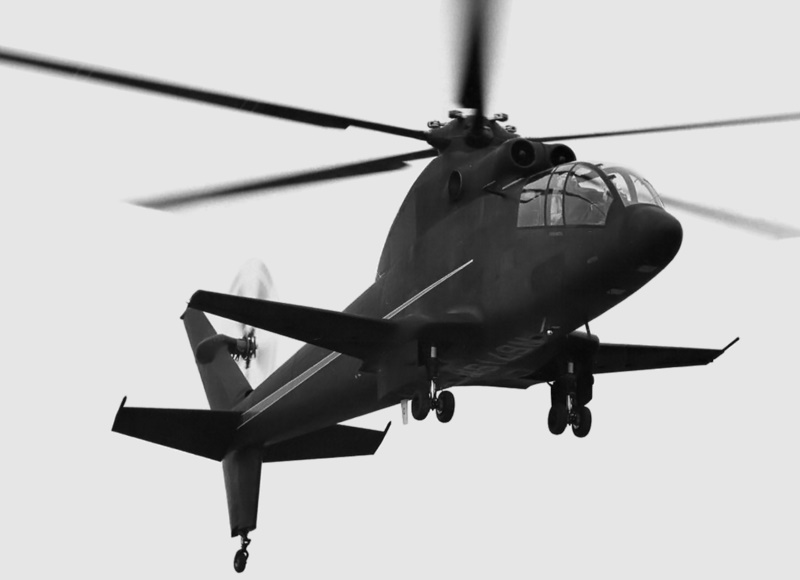
The two aircrew sat in tandem, with the machine flown via sidestick controller, not a stick. The S-67, being a demonstrator, was not fitted up to operational specification, and was unarmed at the outset -- though it would eventually acquire an Emerson Electric TAT-140 turret under the forward fuselage with a 30-millimeter cannon, the turret also being able to accommodate a 20-millimeter cannon as an alternative. The S-67 had a total of four stores pylons under the wings, with photos showing it carrying:
Although videos show the S-67 firing cannon and 70-millimeter rockets, it is unclear that it ever fired TOWs or Sidewinders, with dummy stores carried for advertising purposes. The Blackhawk could carry external fuel tanks, the total external load being 3,175 kilograms (7,000 pounds).
___________________________________________________________________
SIKORSKY S-67 BLACKHAWK:
___________________________________________________________________
main rotor diameter:
18.9 meters (62 feet)
wingspan:
8.33 meters (27 feet 4 inches)
footprint length:
22.6 meters (74 feet 2 inches)
fuselage length:
19.5 meters (64 feet 1 inch)
height:
4.57 meters (15 feet)
empty weight:
5,680 kilograms (12,525 pounds)
loaded weight:
8,390 kilograms (18,500 pounds)
MTO weight:
11,010 kilograms (24,270 pounds)
maximum cruise speed:
325 KPH (200 MPH / 175 KT)
service ceiling:
5,180 meters (9,700 feet)
hover ceiling (in ground effect):
2,950 meters (20,000 feet)
hover ceiling (out of ground effect):
1,980 meters (6,500 feet)
range, internal tanks:
355 km (325 MI / 280 NMI)
___________________________________________________________________
The primary role envisioned for the S-67 was as an anti-armor / combat support gunship, though it was also seen as useful for scout and combat search-&-rescue (CSAR) roles. It had a cabin behind the cockpit that could accommodate six fully-equipped troops, or a rescue team. The idea of a gunship that could carry a squad of troops had its attractions, the idea being that the gunship could drop off the troops and then provide them with fire support. The Soviet Mil Mi-24 "Hind" gunship could also carry a squad of troops -- but it didn't work out, such a tactical scenario not being all that useful, and the troops ending up being an encumbrance in the gunship role. The crew compartment of the Hind was occasionally used by a rear gunner, who could fire a window-mounted light machine gun, one gun mounted on each side of the fuselage, to provide rear cover.
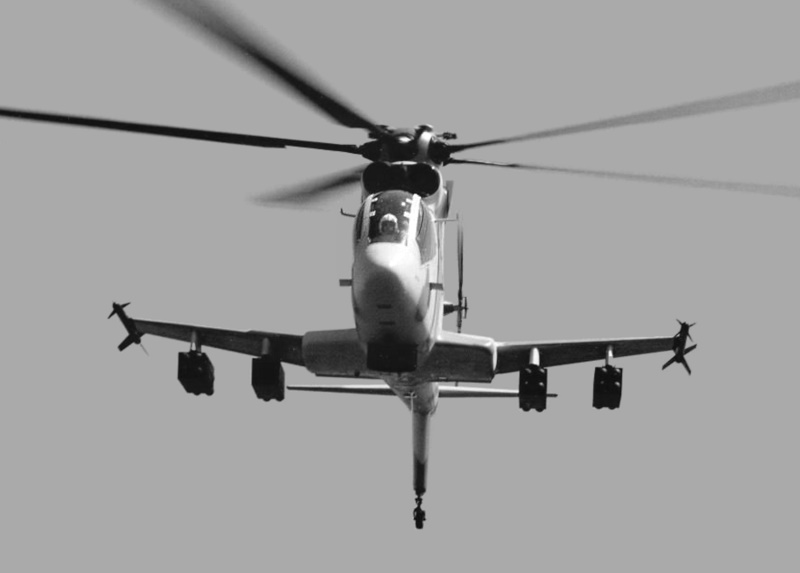
In any case, test pilots found the S-67 very pleasant to fly. It was highly maneuverable, able to perform loops, rolls, and "split-S" aerobatics during flight demonstrations. In 1970, the S-97 set speed records for helicopters without auxiliary propulsion (read as "not a compound helicopter") 355 KPH (220 MPH / 191 KT) over a 15:25-kilometer course, and 348 KPH (216 MPH / 188 KT) over a three-kilometer course. The US Army did provide modest funds to support flight testing, and performed evaluations on the machine; but when the AAH program was set up, the S-67 couldn't meet its specs, and so it did not compete. Sikorsky did offer an "S-71" for the AAH, with the rotor and dynamic systems of the S-70 Black Hawk, but it didn't make the initial cut in the competition and never flew.
The Blackhawk was used as a flight test vehicle for a "fan-in-fin" -- AKA "fantail" or "fenestron" anti-torque system, in place of the tail rotor; the fan had a diameter of 1.42 meters (56 inches). The fantail scheme was aerodynamically cleaner and also safer, the tail rotor often being involved in tree strike and ugly ground accidents. In this configuration, the S-67 attained 370 KPH (230 MPH / 200 KT) in a dive.
Following the evaluation, the S-67 was restored to its earlier tail-rotor configuration, to be modified and sent on a tour to see if Sikorsky could find foreign buyers. The modified machine was closer to a production spec, and had six stores pylons instead of four, allowing it to carry stores loads such as 24 TOWs.
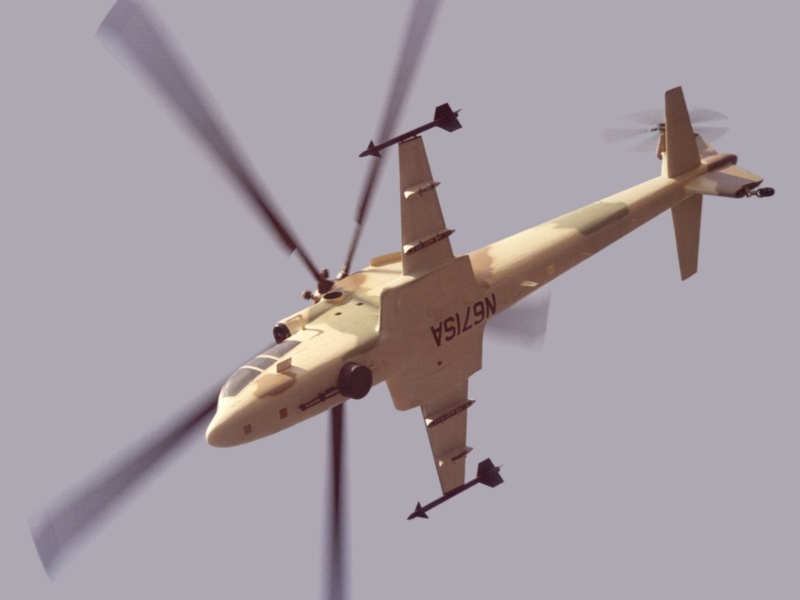
Unfortunately, the S-67 crashed on 1 September 1974, in the course of an aggressive flight demonstration at the Farnborough air show in the UK. Test pilot Stu Craig was killed immediately, while test pilot Kurt Cannon died nine days later. That was the end of the program. Sikorsky would never develop a production dedicated helicopter gunship.
BACK_TO_TOP* In 1981, the US Army issued a request for proposals for a "Light Helicopter Experimental (LHX)", which was to replace the Bell UH-1 utility helicopter, the Bell AH-1 gunship, and the Hughes OH-6 and Bell OH-58D scout helicopters. The Army was contemplating purchase of 5,000 machines.
That quantity led to significant contractor interest and the formation of two competing teams -- one consisting of Bell and McDonnell Douglas, the other of Boeing and Sikorsky. By the late 1980s, both teams had submitted proposals, though by that time the total buy had shrunk to 2,096 machines, since the Army had decided one helicopter wouldn't be suited to both utility and gunship / scout roles; the S-70 Black Hawk was seen as good enough for the utility role. The Boeing Sikorsky LHX design won the competition in April 1991, though the program continued to be a shrinking target, the total buy having been further cut to 1,292 in 1990. The original contract funded construction of four "YRAH-66 Comanche" prototypes, though this was cut to three prototypes in 1992 and then to two prototypes in 1994.
The end of the Cold War and the disappearance of the formidable Soviet rival meant that acquiring a new-technology helicopter wasn't as urgent as it had been, but the initial YRAH-66 prototype flew in 4 January 1996, followed by the second in March 1999. The program survived, for the moment.
* The RAH-66 Comanche was a stealthy helicopter, made largely of composite materials, with a fantail rotor in a tee tail, and retractable taildragger landing gear. The main rotor had five blades and was also of composite construction; the blades featured downturned tips, added after early prototype flights. The tee tail eventually acquired endplate fins, to solve buffeting problems revealed early on; the endplate fins were canted inward, to reflect radar signals upward instead of back to a radar transmitter.
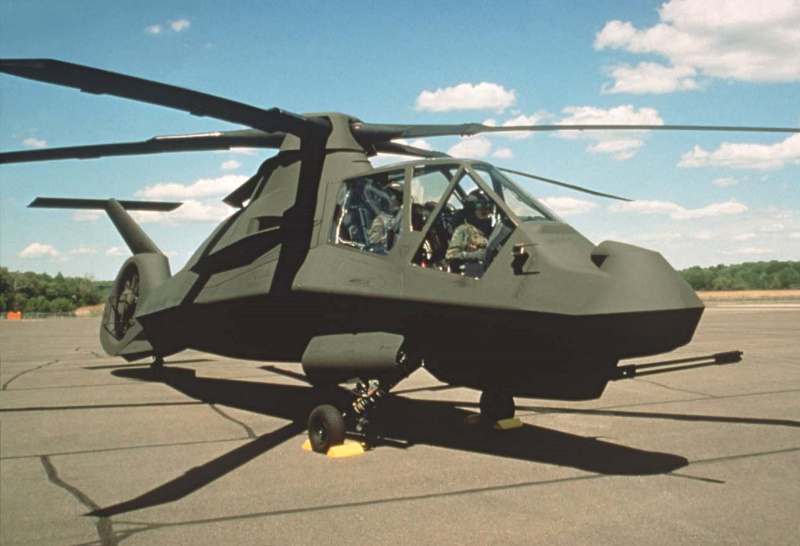
The rotorcraft was powered by twin LHTEC (Allison/Allied Signal, now Rolls-Royce/Honeywell) T800-LHT-801 turboshaft engines, providing 1,068 kW (1,432 SHP) each, 17% more power than the early production T800 engine used on the prototypes. There was also a Williams Research WTS124 "secondary power unit (SPU)" turbine to provide engine starting and ground power. The engine installation was optimized to reduce infrared signature.
___________________________________________________________________
BOEING SIKORSKY RAH-66 COMANCHE:
___________________________________________________________________
main rotor diameter:
12.2 meters (40 feet)
fantail diameter:
1.37 meters (4 feet 6 inches)
fuselage length (excluding gun barrel):
13.2 meters (43 feet 4 inches)
footprint length:
14.28 meters (46 feet 10 inches)
tail height:
3.37 meters (11 feet 1 inch)
empty weight:
4,090 kilograms (9,020 pounds)
max take-off weight:
5,895 kilograms (13,000 pounds)
maximum speed:
325 KPH (200 MPH / 175 KT)
endurance:
2 hours 30 minutes
ferry range (with external tanks):
2,335 KM (1,450 MI / 1,260 NMI)
___________________________________________________________________
The Comanche was fitted with a GIAT turret containing a three-barreled General Dynamics 20-millimeter Gatling cannon, with up to 500 rounds of ammunition -- though 320 rounds was a more appropriate mission load. Missiles were carried in a conformal weapons bay on each side of the fuselage, with the missiles mounted on doors that popped open for firing. Each bay could accommodate three Hellfire anti-armor missiles, or six Stinger air-to-air missiles, or other stores. Removeable stub wings could be attached to carry four more Hellfires; or eight more Stingers; or 70-millimeter unguided rocket packs; or 1,023-liter (270 US gallon) external tanks. With external tanks, the Comanche could self-deploy to foreign operational theaters.
The Comanche was flown by a triple-redundant fly-by-wire flight control system, with both crew using a sidestick controller. The crew sat in tandem, with the pilot in front and the weapons system officer (WSO) in back. The cockpit was pressurized by the SPU to block out chemical or biological agents. The crew had identical "glass cockpits", each with a 203 x 152-millimeter (8 x 5-inch) color multi-function display and a 198 x 127-millimeter (7.8 x 6-inch) monochrome touch display, as well as wide-field helmet-mounted sights.
The RAH-66 had a Global Positioning System / inertial navigation system, with the multi-function displays presenting a moving map to the crew. The rotorcraft featured a sophisticated combat avionics suite, named the "Mission Equipment Package (MEP)", which provided:
All the imaging systems had narrow, medium, and wide fields of view. A Longbow millimeter-wave (MMW) fire-control radar, primarily to be used for MMW Hellfires, could be mounted above the rotor hub, though not all Comanches were to be fitted with the radar.
The Comanche included an automated defensive countermeasures systems as well, including threat warning systems, chaff-flare dispensers, and RF jammers. Along with the combat systems, the RAH-66 also had built-in test systems to ease maintenance. It was covered with access doors, some of which could be used as work stands, and was designed to be easily maintained, as well as rapidly turned around between sorties. It could be quickly kitted up for hauling on a C-130 Hercules cargolifter.
* The Comanche was an impressive machine, featuring the most advanced combat systems and superb performance. Prototypes demonstrated speeds of 323 KPH (200 MPH / 175 KT) in level forward flight, 148 KPH (92 MPH / 80 KT) flying sideways to the left, 120 KPH (74 MPH / 65 KT) flying sideways to the right, and even 130 KPH (81 MPH / 70 KT) flying backwards. It was also far stealthier than any existing US Army helicopter.
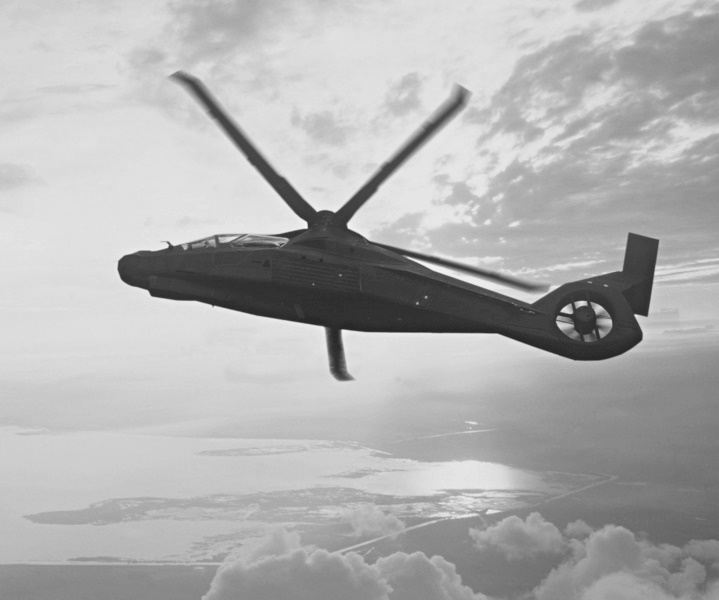
The Comanche finally entered "Engineering & Manufacturing Development" phase on 1 June 2000. However, the program was still in flux, and in late 2002, the Army came forth with a yet another procurement plan that cut the total number of Comanches to 650. That wasn't the end of the matter either; the program finally ran out of steam completely and was axed in early 2004. The Army didn't even try very hard to hang on to the Comanche, since it wasn't really needed for their operational requirements and the money seemed better spent elsewhere. A total of $7 billion USD had been spent on the program, with only the two prototypes built, though five evaluation machines were being manufactured.
The result was that the Army's existing scout helicopter, the Bell OH-58D Kiowa Warrior, was forced to soldier on -- and as it turned out, soldier on for longer than anyone expected. The Army did try to obtain a replacement, conducting a competition for an "Armed Reconnaissance Helicopter (ARH)", with a Lockheed-Bell collaboration winning the award in 2005 with the "ARH-70", based on the Bell Model 407 commercial utility helicopter. It ran into cost overruns, and was canceled in 2008.
The Army restarted the ARH competition as the "Armed Aerial Scout (AAS)" effort, but that went into limbo too. The OH-58D was then phased out of service, leaving the Army with a capability gap. From 2018, the Army conducted a "Future Attack Reconnaissance Aircraft (FARA)" competition, more or less reviving the Comanche requirement -- and then cancelled it abruptly in 2024. The Ukraine War had demonstrated that the helicopter gunship could not survive on the modern battlefield, and drones were absolutely the future for the scout role.
BACK_TO_TOP* Sources include:
The S-67 is not well-documented, most of the information provided here being obtained from a writeup on the Sikorsky website, with backup from a writeup on the MilitaryFactory.com website.
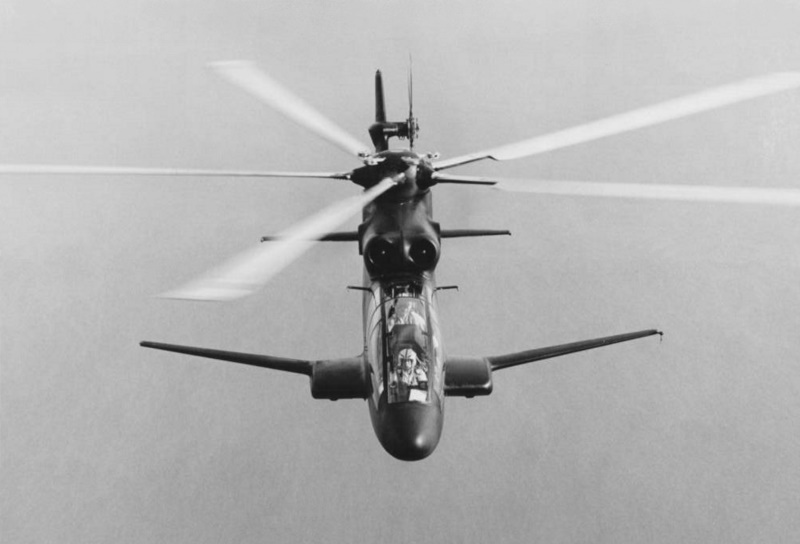
* Illustrations credits:
* Revision history:
v1.0.0 / 01 oct 16 v1.0.1 / 01 sep 18 / Review & polish. v1.0.2 / 01 sep 20 / Illustrations update. v1.0.3 / 01 sep 20 / Illustrations update. v1.0.4 / 01 jun 22 / Review & polish. v1.0.5 / 01 may 24 / Review & polish. (+)BACK_TO_TOP
